A Biased View of Insolvency Practitioner
A Biased View of Insolvency Practitioner
Blog Article
The Insolvency Practitioner PDFs
Table of ContentsThe Only Guide to Insolvency PractitionerUnknown Facts About Insolvency PractitionerHow Insolvency Practitioner can Save You Time, Stress, and Money.All About Insolvency PractitionerThe Greatest Guide To Insolvency PractitionerThe Basic Principles Of Insolvency Practitioner 3 Easy Facts About Insolvency Practitioner Explained
Insolvency is when obligations are higher than the value of the firm, or when a debtor can not pay the financial debts they owe. A firm can come to be bankrupt because of a variety of circumstances that bring about bad cash flow. When confronted with insolvency, an organization or individual can get in touch with financial institutions directly and restructure financial debts to pay them off.:max_bytes(150000):strip_icc()/accountinginsolvency_definition_final_primary_1013-ec9f30044d93461fb78191b77bbcbd17.jpg)
Service proprietors might call financial institutions straight and restructure financial obligations right into more workable installments. Financial institutions are normally open to this method because they want to be repaid and stay clear of losses, even if the settlement is on a delayed schedule.
The proprietor produces a proposal describing exactly how the debt might be reorganized utilizing cost decreases or other strategies for support. The proposition reveals financial institutions exactly how business may produce sufficient capital for successful operations while paying its debts. Normally, a forgiven financial obligation might be considered income by the Irs (IRS).
Fascination About Insolvency Practitioner
When an organization needs to pay boosted costs for items and services, the company passes along the price to the customer. As opposed to pay the boosted expense, lots of customers take their business somewhere else so they can pay less for a product or service. Shedding customers results in losing income for paying the firm's lenders.
Business may end up paying huge amounts of money in problems and be not able to proceed procedures. When operations discontinue, so does the business's revenue. Absence of income results in unpaid costs and lenders requesting money owed to them. Some firms become insolvent due to the fact that their products or services do not evolve to fit customers' transforming demands.
6 Simple Techniques For Insolvency Practitioner
Expenses surpass revenues and costs continue to be unpaid. Kinds of bankruptcy consist of cash-flow insolvency and balance-sheet insolvency. Cash-flow insolvency occurs when a business has the possessions to cover their financial obligations but they are in the wrong type, such as real estate rather than fluid funds. Balance-sheet bankruptcy, on the other hand, shows an absence of properties in any kind of form to cover debts.
The internal revenue service states that an individual is bankrupt when the complete obligations go beyond complete possessions. Insolvency Practitioner. A bankruptcy, on the various other hand, is an actual court order that shows just how a financially troubled person or company will certainly repay their creditors, or how they will market their properties in order to make the payments
See This Report on Insolvency Practitioner
When a firm or person is financially troubled, they can not satisfy their monetary commitments. Insolvency is not the very same as personal bankruptcy, although a business that has actually become financially troubled might file for insolvency. Bankruptcy is the state of not being able to pay your additional reading obligations while insolvency is a legal process to release your financial debts.
Understanding the aspects that can bring about insolvency, such as overspending, can aid you avoid insolvency and its repercussions.
The smart Trick of Insolvency Practitioner That Nobody is Talking About
It is popular that directors and policemans of firms (and supervisors of limited liability business) owe fiduciary duties to their companies and their shareholders (or members). These fiduciary commitments are specified by state statutes and, though there are variants from one state to another, they generally consist of a task of loyalty and a duty of treatment.
The duty of care calls for directors and officers to work out persistance, to make educated choices, and to act in good faith so that their actions remain in the very best rate of interest of the business. Past the extent of this conversation, some states allow these responsibilities to be limited either by so noting in the business records or abiding with various other requirements.
The Main Principles Of Insolvency Practitioner

Be mindful concerning giving investors favoritism at the expenditure of lenders (e.g., licensing and moneying a dividend or a stock redemption). Beware about favoritism in between courses of investors. Clear up efforts to find out all the facts prior to taking a specific program of activity; directors must really believe that any type of choices made remain in the very best passions of the company in its totality (i.e., choices will be reviewed in hindsight due to the result of such actions on the company).
In any insolvency or bankruptcy proceeding, repayments made to certain lenders at the expense of various other financial institutions can be clawed back, particularly if there is some connection in between the business and the creditor. Take into consideration official website suggesting at an annual investor conference (or any type of various other conference of investors) a resolution affirming that read review all previous service choices and actions taken by the directors and officers of the company were absorbed good confidence after an exercise of practical care.
The 15-Second Trick For Insolvency Practitioner
Fully divulge any type of individual or service partnerships with celebrations beyond of deals entailing the company to avoid the look of a problem of passion. In assessing potential fund increasing transactions or a sale of possessions of the struggling corporation, understand that these deals might be looked at later in light of any kind of subsequent growth of supervisors' fiduciary duties to include creditors.
Report this page